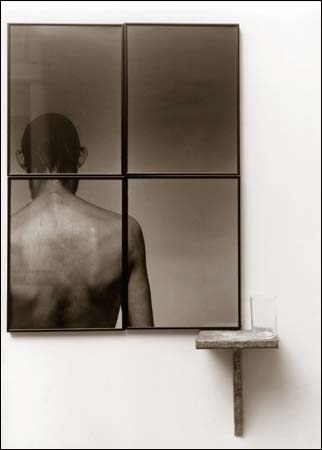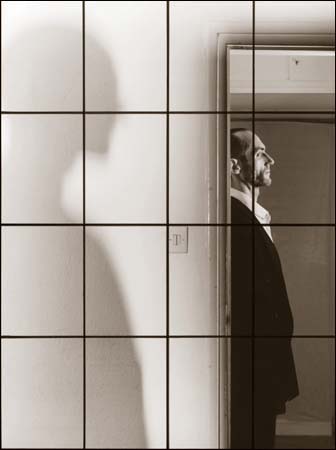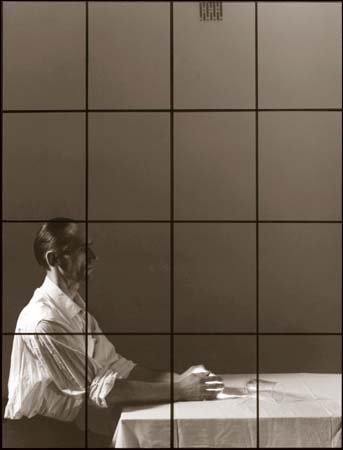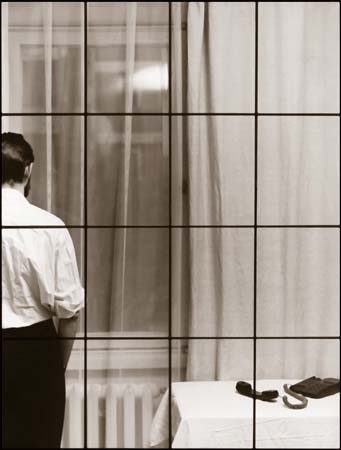
7 - 27 V 1999 (PHOTOGRAPHIC WORKS)
![]()

No title, 1998. Photography and object, 110 / 70 cm.
![]()

No title, 1998. Photography, 160 / 120 cm.
![]()
A SCREEN OF PLEXI
Devoid of details, raw, almost abstract interior. A figure of a middle-aged man squeezed behind the door-frame, seen at other times as he turns around. Single, seemingly accidental, although absolutely necessary, objects-attributes, marking the limits of the meaning of those scenes - a telephone, a glass of water, a wall one can hide behind. Everything is kept within the naturalistic scale and the distinguished gamut of concrete, ranging from white to black through Ilford-like, soft shades of grey.
This might be the briefest and the most objective description of Jarosław Bartołowicz's photography. He is a painter, installation artist, a photographer and one of the most characteristic figures on the artistic scene in Gdańsk of the 1990s. Even though he has been living in Warsaw (his home town) for a few years now, his approach to art - balanced, saturated with metaphysical reflections and existential detachment - was undoubtedly shaped by Gdańsk of the 90s, with its atmosphere of the encounters of artists engaged in social subjects, the artists gathered around the WYSPA-PROGRESS Gallery (THE ISLAND-PROGRESS Gallery); Gdańsk with its multi-media atmosphere of "the new Gdańsk school" (created by such eminent personalities as Witosław Czerwonka, Grzegorz Klaman, Andrzej Awsiej, Marek Targoński, Robert Rumas and Piotr Wyrzykowski), with the pressure of contemporary subjects, revolving around the problems of identity, place, awareness and social role of an artist, the problems of self-identification and knowledgeable building of new signs and symbols, referring to the reality flowing nearby. When Klaman was building his architectural monuments, trying to inscribe his sculptures in the urban landscape of the city, when he locked up human remains in glass reliquaries or when Rumas was tearing apart the fetishes of the Catholic faith, Marek Targoński and Jarosław Bartołowicz, each, of course, using his own, different language, were trying to find and define a place of their own, a place for their sensitive, detached and introvertic personalities. They were not fascinated by the strength or effectiveness of the social programmes of the Beuys of Gdańsk, as they were not interested in producing commentaries to the rapid transformation of new Polish society, to the freedom of slogans and the universal accessibility of all kinds of goods (various products, gestures, places and ideas). They were not completely indifferent to the problems roughly sketched above, so they thoughtfully answered the queries posed. Photo-installations by Jarosław Bartołowicz, like "Radio - the Sending of the Spirit" (1994), "Transformation" (1994) or "Europe" (1995), created during successive group exhibitions of the artists of the "Łaźnia" ("The Baths") in Gdańsk, became the indispensable and much desired niches of reflection, appearing between the categorical sentences-provocations by Rumas, further neoexpressionist explosions of energy, leading to the deconstruction of meaning by Klaman, shamanistic formulas of Rogulus-Rogulski or the balanced, discretely hidden processes of objects by Targoński.
And although Jarek Bartołowicz five or six years ago decided to use the noble medium of photography, he has not broken his links with the problem of representation of presence in its full dimension, the problem of manifestation of one's attitude and thinking in terms of concomittance, participation and compassion - namely, a spatial problem, created in situ, like an installation or performance. Perhaps that is why his photographic images possess the quality of reality, they question the artificiality and the feeling of security, accompanying all photographs taken in the studio, they break the convention of the frame which instead of protecting things hidden, interior and intimate in a comfortable quotation of conventionality, becomes in Bartołowicz's work
a fragile suggestion of a screen, a screen of plexi, behind which lies his private domain of fears, prayers, uncertain presence, expectations and doubts...
There are no solutions to be found in his photographs. It is impossible to find the words which could describe this state of suspension: the state between disappearance and appearance of the new, the state between the message and possibility of answering to it, between the need to make a decision and the uncertainty of all resolutions. November days are most favourable as far as reflection is concerned ("it is the most cruel and difficult month to live through", the artist adds), so it is small wonder that November appears in the titles of his most recent works: "November - the Hunger of Faith", "November - the Latest News"... Its sentimental and nostalgic aura also stretches over other works by Bartołowicz, those untitled by nature, although no banal elements of various definitions of November, such as the autumn rain, Halloween ghosts or candles, appear in his works.
The decadent taste of the postmodern which we can find in most of his otherwise clear compositions - which are, in fact, conservative, sharp and denuded to the point of exaggeration - is mainly created by the characteristic and long unchanged aura of the images. An anonymous interior, devoid of details, the gestures of the model, concentrated and clear-cut, although simultaneously mysterious and unsaid (the model would be the photographic alter ego of an artist, i. e. of Bartołowicz himself in this case), the escape from visual confrontation in spite of the total denudation of the figure, the elimination of narcisstic associations by means of "natural" poses and the ordinariness of the mask - they all result in the end in an impression of uncomplicated presence - or, at other times, of some mysterious process without beginning and end, and the image becomes the evidence of the vision of a moment, although we do not know what made it important, why it was singled out and retained. An unheard silence, oozing from those photographs, leaves the observer in a difficult position of an ambiguous voyeur who watches something very intimate and strange, but at the same time something quintessential. Those frozen moments, which usually last a fraction of a second (or eternity, perhaps?), Bartołowicz makes monumental by means of their scale. He uncovers the solemnity of apparently meaningless gestures. He does not look for any associations and makes nothing easy. He counts on the observer's empathy, on the confrontation with his internal, spiritual space, on the memory of similar moments which we experience differently every time.
Bartołowicz's photographs are like the vision of the world that surrounds us. Jean Baudrillard would have said that it is the awareness of constantly overlapping microprocesses which cease instantly. Naturally, Bartołowicz respects these anonymous fractions of gestures and moments making up the sum of our existence and does not allow himself to follow the nihilistic cult of transitoriness. He does not use accidental, dynamically smudged photographs or fast reproduction techniques which give evidence to the brevity and transitoriness of life. He is neither a medialist nor a nihilist. He does not want to prove anything and he is not trying to convince us about anything. Using his own image he somehow comes close to the modern form of the self-portrait, to the mimicry of covers and openings which create the mythology of their own figure, created in turn by means of figures known from the artist's pictures. However, it is not his main goal. Registration - yes, but not creation of presence, camouflaged in details and contents. Bartołowicz can afford to be authentic, to show the openings behind which there is only he: his sensitivity and his character. So where does his creative gesture fit (so as not to say: art)?
If we look at the individual sequences making up the great photographic panneaux of single scenes we will amazingly discover that most of them contain perfectly photographed emptiness - a more or less grey space, in other cases an almost anonymous whiteness of a curtain, a wall, or at the most some banal fragment, describing reality - like a bicycle standing against the wall or a door-frame. Does not the "Nothing" contained in those modules create the aura of authenticity that is so difficult to grasp? Do not those fragments, least meaningful iconically, contain the mysteriousness that is difficult to grasp, the timeless suspension, the tension generated by the simplest of gestures? The authenticity of denudation, honesty of intentions instead of a complicated context and quotational traps? The dramatic existentialism conspiring with postmodern decomposition?
In his black-and-white compositions, always peaceful and contemplative (even when he breaks a glass, striking it with a rod), Bartołowicz seems to oppose the chaotic energy of every-day life, the idiotic rush, the low value of various discoveries and the so-called success, the unfounded desire to destroy one's opponents, and finally the rush towards... death. He juxtaposes the inflated, glittering images of electronic media and the honesty of limited responsibility for a gesture with the meaning which may be revealed by its means. The durability of the photographic image and the conservative workshop are the reverse of easily used and equally easily destroyed means of electronic recording. The plexi separating us from those images does not seem to protect the artist in his reproduced shelter, on the contrary - it seems to uncover it and to draw us closer to him, leaving the act of settling the accounts with the hero-victim to individual conscience. And if not with him, then at least with the hypostasis of his thoughts, with the apparent moments of experiencing one's ideals and doubts. The truth, enchanted in life, in our minds, the gestures and reactions meaning the acceptance or elimination of certain territories of sense may be as well replaced by emptiness, by emotional indifference, by unwillingness to make the effort necessary for the feeling of commiseration. Imitating, and even parodying the gestures of others, we learn to make contact with the nakedness of being. Thanks to such photographs as those presented at the exhibition we communicate with the difference of the Other, we open up to his states of being, we participate in the struggle with our own shadow which is nothing else but the fear of disappearance, the fear of passing unnoticed, passing away without a trace, the fear of our anonymous death which means nothing to everyone else.
Jolanta Ciesielska, Łódź, April 1999
translated by Maciej Świerkocki
![]()

"November - the Hunger of Faith", 1999. Photography, 160 / 120 cm.
![]()

"November - the Latest News", 1999. Photography, 160 / 120 cm.
![]()
Copyright ©1999 Jarosław Bartołowicz, Jolanta Ciesielska, Galeria FF ŁDK